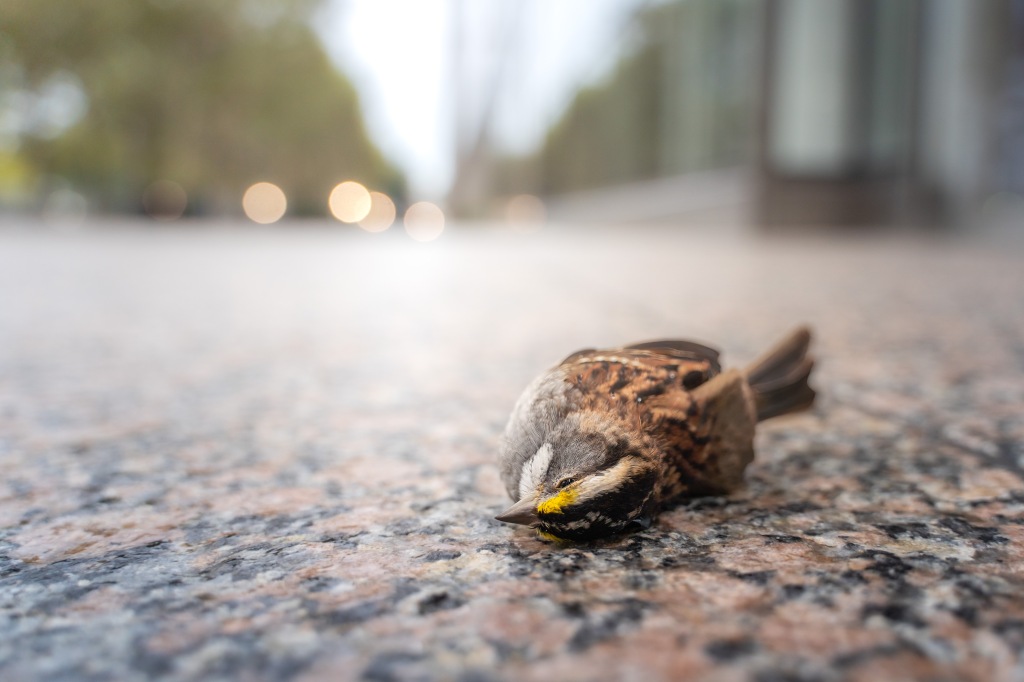|
Getting your Trinity Audio player ready...
|
In their latest research article, Sara Kross, Katherine Chen, Benjamin Van Doren and colleagues utilise 5 years of bird collision counts in New York City to determine the influence of nocturnal weather conditions and bird migration traffic rates on collisions with buildings.
Migration is already a particularly dangerous part of the annual life cycle of many birds, and it’s estimated that collisions with windows kills up to one billion birds across North America each year. New York City is one of the world’s most recognizable megacities, but its brightly-lit iconic skyline also makes it a hotspot for bird collisions.

NYC Audubon scientists and partners have focused on this problem for decades. Now, our new research on weather’s impact has revealed some important findings on how to make solutions more effective.
Lured by light, killed by glass
Each fall, billions of birds migrate from their breeding grounds in the northern hemisphere to their foraging and overwintering sites in warmer climes, and then make the return trip in the spring. Birds that weigh as much as a pencil fly from the boreal forests of Canada to the rainforests of Central America in a matter of days. These migrants delight bird watchers in New York City’s parks, but far too many otherwise healthy birds are injured or die when they collide with the City’s gleaming towers. In fact, NYC Audubon estimates that nearly a quarter million birds die from injuries caused by window collisions in the City each year. The causes? Glass and light.
In late 2019, New York City notably passed landmark legislation requiring all new construction to use bird safe materials. This will eventually make the City far easier to navigate for birds, but another action likely to decrease bird collisions is turning off unnecessary night-time lighting. The light pollution from New York City, visible from hundreds of miles away, draws migratory birds into the City, disorienting them and making them more susceptible to collisions with windows. Across the continent, “Lights Out” programs—where building owners and tenants are encouraged to turn out unnecessary lights during migration—can reduce the number of birds drawn into the city, thus reducing collision risk at a window-level scale.
Making “Lights Out” more practical
Those Lights Out programs are largely voluntary, and we applaud the homeowners and building managers who agree to turn their lights out at night. However, for many large buildings, a season-long Lights Out program is a hard sell and does not feel practical. The lengthy time frame (in New York City, April 1–May 31 for the spring and August 15–November 15 in the fall) has been a barrier to full participation in Lights Out.
Last year, we—scientists from NYC Audubon, Columbia University, the University of Canterbury, the American Bird Conservancy, Great Hollow Nature Preserve & Ecological Research Center, the Cornell Lab of Ornithology, and the University of Illinois at Urbana-Champaign—set out to remove this barrier. In our research, we wanted to further our understanding of collision risk factors and hone in on the most dangerous nights for birds, in order to facilitate more effective calls for widespread Lights Out participation.
Recent advances in our ability to utilize radar technology can give us a full appreciation of the sheer number of birds moving each night. For example, the BirdCast tool from the Cornell Lab of Ornithology allows us to better predict nights that are likely to be problematic for bird collisions.

However, we realized that sometimes nights that were predicted to be especially risky for bird collisions turned out to be below average, while other nights that weren’t expected to be a problem turned into major mortality events. We thought that weather might explain some of this variation.
Windy and cloudy conditions
We built on NYC Audubon’s Project Safe Flight—where teams of dedicated volunteers monitor specific buildings across the City each morning during the spring and fall migrations seasons—and added a number of local weather data factors to avian migration data collected via radar to see if the weather variables would be important predictors of bird collision data. We created statistical models that included nightly data on bird migration along with local weather station data for wind speed and direction, cloud ceiling height, and visibility. We compared those to the number of birds collected each day around 27 buildings in Manhattan, Brooklyn, and Queens over a five-year period.
Our analyses indicate that weather conditions combined with migration traffic patterns are important predictors of bird collision risk. Generally, bird collision rates were higher when there was more migration traffic in the region, but this was affected by weather too. We found that nights with headwind conditions for migrating birds and winds that blew birds toward the coastal city had higher numbers of window collision victims, and that visibility also played a role. We found higher collision counts to be associated with winds coming from the North and the West in spring and with winds coming from the South and West winds in fall.

In spring, birds migrate North and, therefore, headwinds from the North are unfavorable. Conversely, in fall, when birds are flying south towards their wintering grounds, winds coming from the South are unfavorable. In both seasons, winds from the West push migrating birds toward our coastal city and its bright lights. These wind conditions, along with poor visibility at higher altitudes, can lead to birds flying at lower heights where they are at a much higher risk of colliding with buildings.

Effective actions
Our results will allow organizations and individuals to tailor their calls for participation in Lights Out programs using bird migration and weather forecasts. If we can garner greater participation from buildings across the city on the nights that are likely to be most dangerous, we hope to see fewer birds colliding with buildings.
Keep in mind that while we focused on large buildings in New York, every window is dangerous for migrating birds. You can take action by using bird-safe materials for your windows and by turning unnecessary lighting out at night—especially when migration traffic is high and birds are likely to face headwinds or low clouds.
Visit nycaudubon.org/artificial-light to learn more about the dangers of light pollution to birds and how you can help prevent collisions in New York City.
Read the full article “Heavy migration traffic and bad weather are a dangerous combination: Bird collisions in New York City” in Journal of Applied Ecology.
